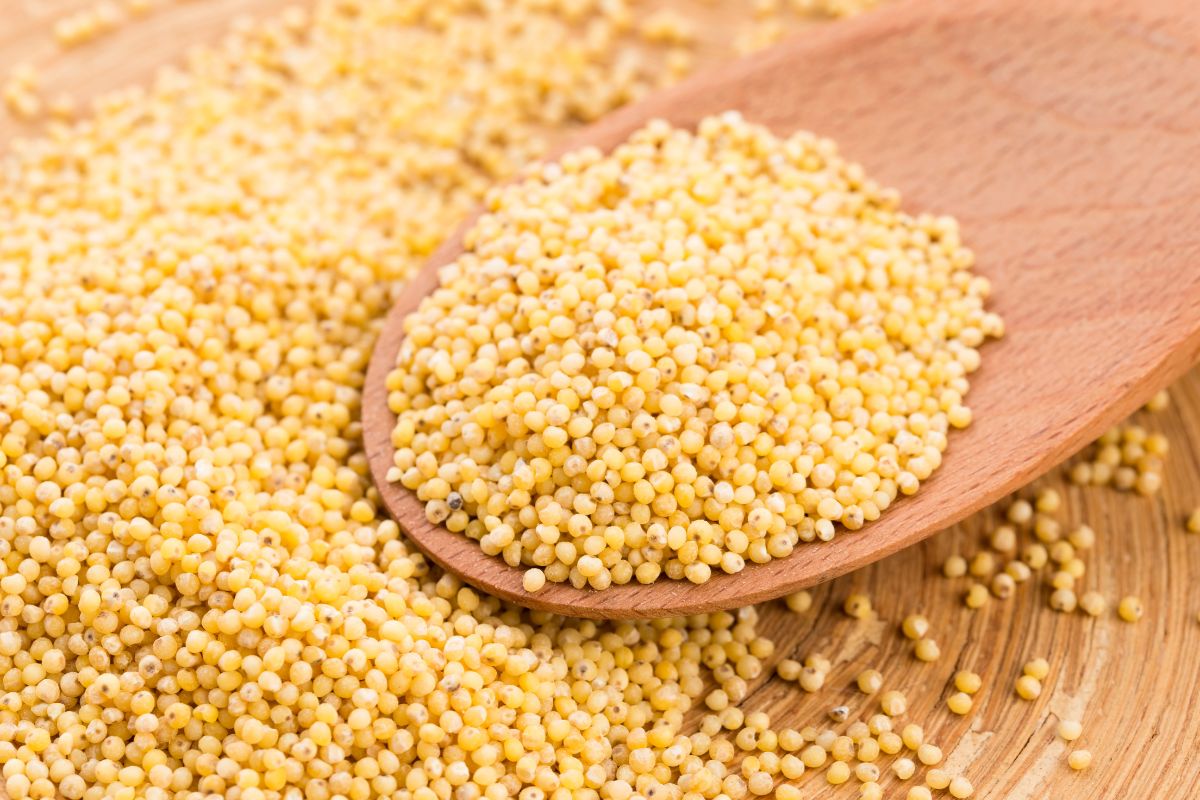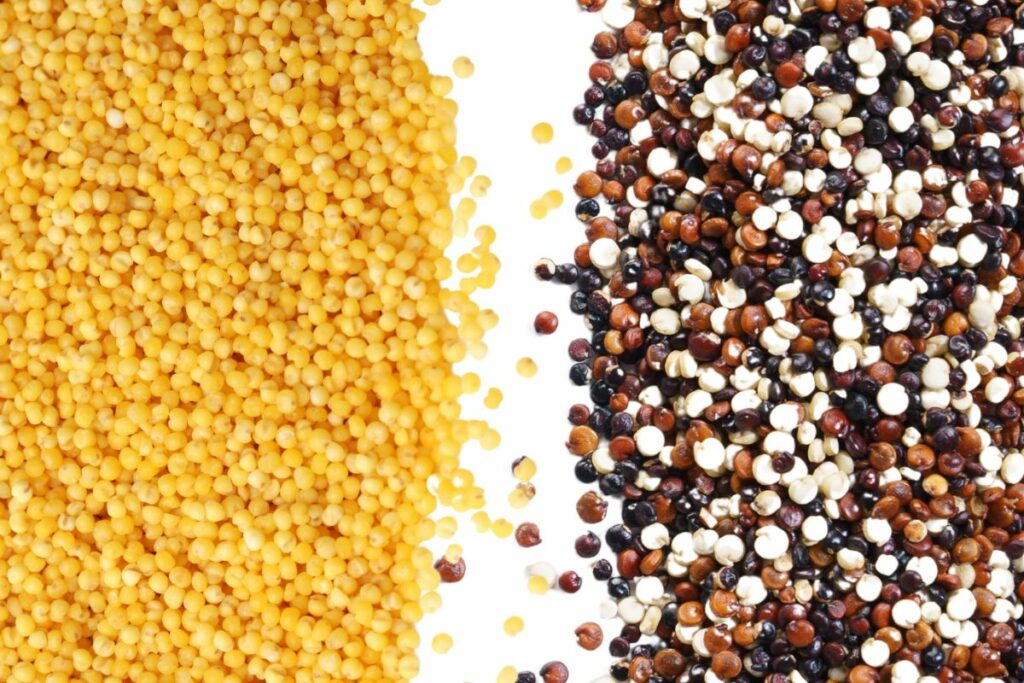If you are looking for health foods to try, then you have probably already heard of quinoa.
One of the foods that are now taking the world by storm is millet. Whole grains such as these have been popularized by health and diet influencers, and are not at the forefront of the whole foods market.
But, you could be wondering what the real difference is between millet and quinoa, what the nutritional values are and which one is best for you.
We can answer these questions in this guide with some of the key differences.
First, let’s go over what millet and quinoa are separately, to distinguish between them.
What Is Millet?
Millet is the term for a group of small whole grains found in India, Nigeria, and Asian countries.
The word millet refers to various different grains from the grass family Poaceae These look like small corn kernels, but are actually classed as cereal.
Most millet will be small and circular in nature, but when they are cooked, they tend to go soft, light and fluffy. It does have a corn like texture, but you will find millet a little bit nuttier in flavor.
In short, millet is a starchy grain that is a great source of protein, fiber, and energy.
It contains lots of vitamins and minerals, and can also contain antioxidants to help boost your immune system. For these reasons, millet has been dubbed a super food by nutritionists.
What Is Quinoa?
Quinoa originated in the Andean region of South America, and is known to come in various colors from red, white, yellow and even black.
Quinoa is a flowering plant from the amaranth family. This herbaceous plant is what produces the edible seeds, which we call ‘quinoa’.
The seeds are high in fiber, rich in protein, vitamins and minerals, much like grains. Due to its high nutritional value, quinoa is now considered a ‘superfood’ for health enthusiasts.
Although quinoa is technically a seed not a grain, it is often referred to as one, and it is eaten in the same way as cereal grains, much like millet.
It is widely loved because it is also gluten free, so it can be consumed by those with celiac disease also.
Similarities Between Millet & Quinoa

There are many similarities between millet and quinoa, which is why the two are often confused for one another.
For instance, millet and quinoa do look very similar in appearance. In addition to this, both quinoa and millet are gluten free grain.
Those who struggle with gluten in their food, or those with celiac disease can happily eat either millet or quinoa.
Millet and quinoa also have the same amount of calories, which is why these two are often substituted for each other within a healthy diet as they are both low in calories.
Both quinoa and millets are great sources of antioxidants. These antioxidants can help protect your body from free radicals, which can contribute to cancer and other health issues.
They are also both good sources of vitamins, minerals, and fiber and both can contribute to healthier digestion.
Additionally, they can be prepared and cooked in the same way, as they will require the same grain to liquid ratio of 1:2 for cooking.
You can also eat either millet or quinoa as a substitute for white rice in many different recipes (for more rice vs millet facts, read here).
Differences Between Millet & Quinoa
One of the main differences between millet and quinoa is that quinoa is the small seeds that come from a herb plant, whereas millet are small cereals that belong to the Poaceae grass family. However, both are considered to be ‘whole grains’.
Another key difference is that quinoa tastes much more like cooked oats or rice, whereas millets have a nuttier flavor.
Millet and quinoa are also different in appearance, as quinoa is more rounded, and only comes in black, white, and red tones, whereas millets are smaller, and may be brown, green, red, yellow, or white.
Quinoa may also not be suitable for some people, as the high calcium and oxalates can put some at risk of developing kidney stones.
If you are prone to kidney stones, or already have them, then it is better to eat millets instead.
That being said, millets have goitrogenic properties, making them unsafe for those who have thyroid related health issues. But, quinoa is safe if you do have thyroid issues.
Also, quinoa has a better glycemic index than millets which can help you control your blood sugar.
Millets also have a large proportion of dietary fiber compared to other staple cereals, which can provide health benefits such as improved gastrointestinal health and blood glucose clearance.
However, quinoa contains slightly more protein, and contains all nine essential amino acids.
Something else to consider is that millets are far more cost efficient, whereas quinoa is more expensive to purchase.
Nutritional Differences

Here we have created a table of some of the key nutritional differences between millets and quinoa per 100 grams.
| Nutrition | Quinoa | Millet |
| Calories | 120 | 120 |
| Carbohydrates | 21.3 g | 23.7 g |
| Protein | 4.40 g | 3.51 g |
| Fiber | 2.8 g | 1.3 g |
| Sugar | 0.87 g | 0.13 g |
| Fat | 1.92 g | 1 g |
| Vitamin A | 5 IU | 3 IU |
| Vitamin B6 | 0.12 mg | 0.10 mg |
| Vitamin B1 | 0.10 mg | 0.10 mg |
| Vitamin B2 | 0.11 mg | 0.08 mg |
| Vitamin B5 | 0.33 mg | 0.17 mg |
| Vitamin C | 0 mg | 0 mg |
| Potassium | 172 g | 62 mg |
| Phosphorus | 152 mg | 100 mg |
| Magnesium | 65 mg | 44 mg |
| Iron | 1.49 mg | 0.63 mg |
| Copper | 0.19 mg | 0.25 mg |
| Zinc | 1.09 mg | 0.91 mg |
As you can see from the above table, there are some real similarities between quinoa and millet in terms of nutritional values, but there are some big differences too.
Is Millet Or Quinoa Better For Weight Loss?
To be perfectly honest, quinoa and millet are both extremely helpful for weight loss. The only real nutritional difference between millet or quinoa is their amino acid content.
In addition, quinoa is considered a complete protein, whereas millet is not. However, as mentioned above, millets are generally much cheaper than quinoa, so if you’re looking for a cost effective option for weight loss, then you should opt for millets.
Final Thoughts
To summarize, millet and quinoa are very similar to each other. Both are great sources of protein, fiber, vitamins and minerals, and are low in calories.
They are also both gluten free and extremely nutritious and can be enjoyed as part of a balanced, healthy diet.
The key differences are that quinoa are seeds, whereas millets are considered a cereal, yet both are whole grains.
They also vary in flavor and appearance, while quinoa is higher in oxalates, and millets are higher in goitrogenic properties.
Which one you choose depends on your dietary requirements, health condition, and personal preference when it comes to flavor.








